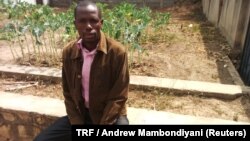As the summer planting season approaches in eastern Zimbabwe, small-scale farmers struggle with familiar questions: When will the rains come, and when should I sow my crops?
This year something else is keeping them awake: In late August the government issued a warning about a potential El Niño weather pattern, associated with changes in weather patterns worldwide.
Should El Niño arrive, Zimbabwe might see normal or higher-than-average rains, said Washington Zhakata, director of the country's Climate Change Department. More likely, though, there would not be enough rain.
"Looking at the past observations ... once an El Niño sets in, depending on the strength and nature of the El Niño, the chances of bad rains or below-normal rainfall in Zimbabwe are between 50 and 65 percent," he said.
In trying to figure out what to plant and when this year, farmers are also missing an old ally: Birds, whose movements traditionally have helped predict coming weather.
Delayed rainfall
In Zimbabwe's Eastern Highlands the farming season typically starts in late October or early November. But in recent years the weather has become less predictable, and that is a growing problem for farmers.
"At times the rainy season is now starting well into December. The weather is now changing," said Leonard Madanhire, a farmer in Zimunya, a village close to the Mozambique border.
Once, he said, farmers watched changes in the environment around them - particularly activity by birds - to work out whether or not they could expect a good season.
"We used to learn a lot from the birds about the seasons.
But these birds have long vanished," he said.
When different species of birds arrived or left told villagers in his subsistence farming community what might be coming: a storm, a change of seasons, even flooding.
Some farmers held off planting until they saw certain species of migratory birds. The appearance of one particular type of stork - known as shuramurove - foretold a good rainy season, for instance.
But most of the birds once relied on - including the stork - have now vanished, he said.
"We last saw them here more than five years ago," said Madanhire.
Absent friends
Togarasei Fakarayi, a programme manager at BirdLife Zimbabwe, a non-profit, said changing conditions in the country were having an impact on birds - and there was a clear link between climate change and the diversity and abundance of bird species.
"Birds are sensitive to environmental changes, in particular habitat changes. Climate change causes habitat changes over time - for instance, drying up of forests, grasslands and wetlands habitats as a result of global warming," he said.
As those changes happen, species may shift or disappear from certain areas, Fakarayi said. More regular dry weather also has led to fires, which can destroy bird habitats.
"Climate change affects routes of migratory birds - in particular food abundance which is key, especially in stopover roosting areas," he said.
Among the birds that have become far less common in Zimbabwe, Fakarayi said, were bateleur eagles and the southern ground hornbill.
Under the country's Parks and Wildlife Act, storks and bateleur eagles are listed as specially protected animals, while the southern ground hornbill is considered as vulnerable, Fakarayi said.
The hornbill's absence is something the farmers of Zimunya know well. In this region, characterized by mountains, forest and montane grasslands, the bird, known as the mariti or matendera, was once much easier to see - and to hear.
"If you hear the deep singing of the southern ground hornbill then you know it's going to rain and you can plan your day. But these birds are now very rare," said Madanhire.
That is also the case for the bateleur eagle, or chapungu, whose presence is synonymous with reliable rains, a bountiful harvest and good luck, said farmer Nicholas Kwadzanai Mukundidza.
"Chapungu is now rarely seen in the area, but this bird was sacred. And the honey bird (tsoro) which used to direct us to beehives in the forest has vanished too," Mukundidza said.
The lack of these birds means that farmers - who until recently combined traditional knowledge with forecasts from the meteorological department in deciding when to sow their crops - find it is harder to plan for changing conditions.
These days, Madanhire said, they do listen to the weather forecasts when they can get them. But, he added with a chuckle, "they are not reliable."
Climate link
Linia Mashawi Gopo, the principal meteorologist at Zimbabwe's Meteorological Services Department, said the department's research indicated some - but not all - farmers use indigenous knowledge to forecast the weather.
"The younger generation prefers scientific forecasts while the older generation use both the (indigenous knowledge) and scientific forecasts," she said.
But older people have found their traditional forecasting methods becoming less predictable over time, she said - in some cases because the indicators they once relied on had disappeared, while in others the behavior of animals and birds had changed.
"This is mostly attributed to climate change," she said.
She said more work was needed to correlate indigenous knowledge of forecasting with scientific methods, and to set up a way to use both sets of information.






